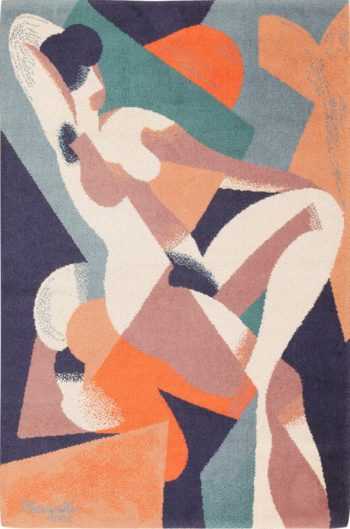Rene Margritte Rugs
View our selection of vintage rugs by artist Rene Margritte:
Vintage Scandinavian Rug by René Magritte 47671
$3,650.00Size: 4 ft 7 in x 6 ft 7 in (1.4 m x 2.01 m)
Learn More About Rene Margritte Rugs
View our entire collection of art rugs and carpets by famous artists
Rene Margritte is one of the most famous Surrealists of all time, rivaled only in stature by Salvador Dali. His paintings depict an eerie dimension that is somehow familiar and reserved, yet shockingly strange. Margritte was born in 1898 in Lessines, Belgium, the son of a textile merchant. He began learning to draw at a young age and it was this early fascination that sparked his future creative ambitions.
Tragically though, when Margritte was fourteen, his mother committed suicide. She did so by drowning, after multiple past unsuccessful attempts. This horrific incident impacted him deeply and would become a subtle influence on his work. In 1916, at age eighteen, he got the chance to attend the Royal Academy of Fine Arts in Brussels. However, he found the experience tedious and unfulfilling, and soon dropped out. His artistic career stalled at that point. It did not officially begin until almost a decade later, after he had served for several years in the Belgian infantry. In 1926, he landed an auspicious contract with the Galerie la Centaure which finally gave him the opportunity to pursue art full time.
The popularity of Rene Margritte reached its zenith when he stopped chasing trends, like cubism and futurism, and embraced his own unique outlook. His surreal masterpieces are notable for many reasons, but especially for how they challenge our perception of reality and their potent emotional quality.
For example, in his seminal work The Treachery of Images, he confronts viewers with the depiction of a pipe and the following phrase written at the bottom in French: “This is not a pipe.” The statement seems nonsensical, as the painting clearly shows a pipe, but that’s exactly the main conundrum. We are only seeing the verisimilitude of a pipe created with oils and pigments, not an actual pipe. The Treachery of Images underlines the obvious disparity between the representation of a thing and the thing itself, while exposing humanity’s innate predilection to regard them, at least subconsciously, as one in the same.
On the other hand, art works like The Menaced Assassin and The Lovers are more sensual than cerebral. The former is a scene of depraved murder that carries the elusive threat of even more violence to come. It was inspired by a still from an old Fantomas film from 1913.
In fact, Margritte frequently appropriated elements from movies and comics. The Lovers is unsettling in a much different way, presenting a man and a woman kissing, their heads bound up strangely in white cloth. They are blocked from true intimacy. The painting conjures up so many ideas of love gone wrong, or how people can be blind to what’s right in front of them. This ghostly, pale cloth is actually a common theme in Margritte’s work.
Even in the Rene Margritte art work “The Menaced Assassin”, there seems to be fabric draped partially over the slain woman’s neck. It’s a motif that can be traced all the way back to Margritte’s first serious trauma. Apparently, when his mother was discovered after drowning, her nightgown had been cast up and tangled around her head by the current of the river.
While it is a myth that Margritte witnessed this firsthand, he may have heard about it from someone else, or extrapolated the visual from his own imaginings. Either way, most of Margritte’s oeuvre are haunted by the death of his mother, leaving the viewer full of latent dread.
Rene Margritte’s life was certainly tumultuous, marked by tragedy, failure, and two World Wars, but he never stopped developing his craft. By the end of his life, Margritte had found major success, becoming a legend not only in the Surrealist movement, but the artistic world at large. Even people who don’t know his name are familiar with his oft-parodied works such as “The Apple Picture” a.k.a. Son of Man.
The ambiguity of his works are their primary charm. What they convey might be frightening, or confusing, but they will always engage the viewer on some deep and mysterious level.

